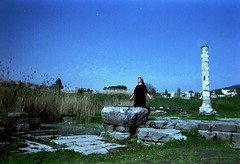European Folk Dress
European folk dress in its present form is a relatively new phenomenon; it appeared in the mid-18th through the 19th centuries. During the Middle Ages, laws restricted the materials, styles and colors that peasants were allowed to wear, and clothing was rather uniform in sober colors. Its elaboration only began when these feudal laws were abolished.
The basic wardrobe of the 18th- and 19th-century peasants consisted of a chemise, a skirt and an apron for women; trousers, a belt or sash, and a T-shaped shirt for men. Cloaks and jackets were worn by both men and women. As these simple pieces began to evolve, geographic differences became more evident and clothing would delineate an affiliation to a group and/or village. Villages were isolated and self-sufficient, with rigid codes that controlled every aspect of daily life and that was reflected in clothing. Men, women, and children would wear the prescribed attire for each stage – or event – of their lives. The most interesting elements of their clothing were its decorative motifs, which could be traced back to pre-historic ritual cloths, stone carvings and ceramic vessels used for ceremonial purposes and had sacred significance.
The world ‘folk’ appeared in the first half of the 19th century, during the Romantic age, when European intellectuals began defining a country’s national character in terms of its folklore. They believed that simple rural life could serve as an example to society at large; rural life was idealized and so was rural clothing. This was no longer limited to villages, but expanded to cities where urban admirers would wear folk attire.
The attention that rural dress received led to its increased elaboration and praise of artisan
